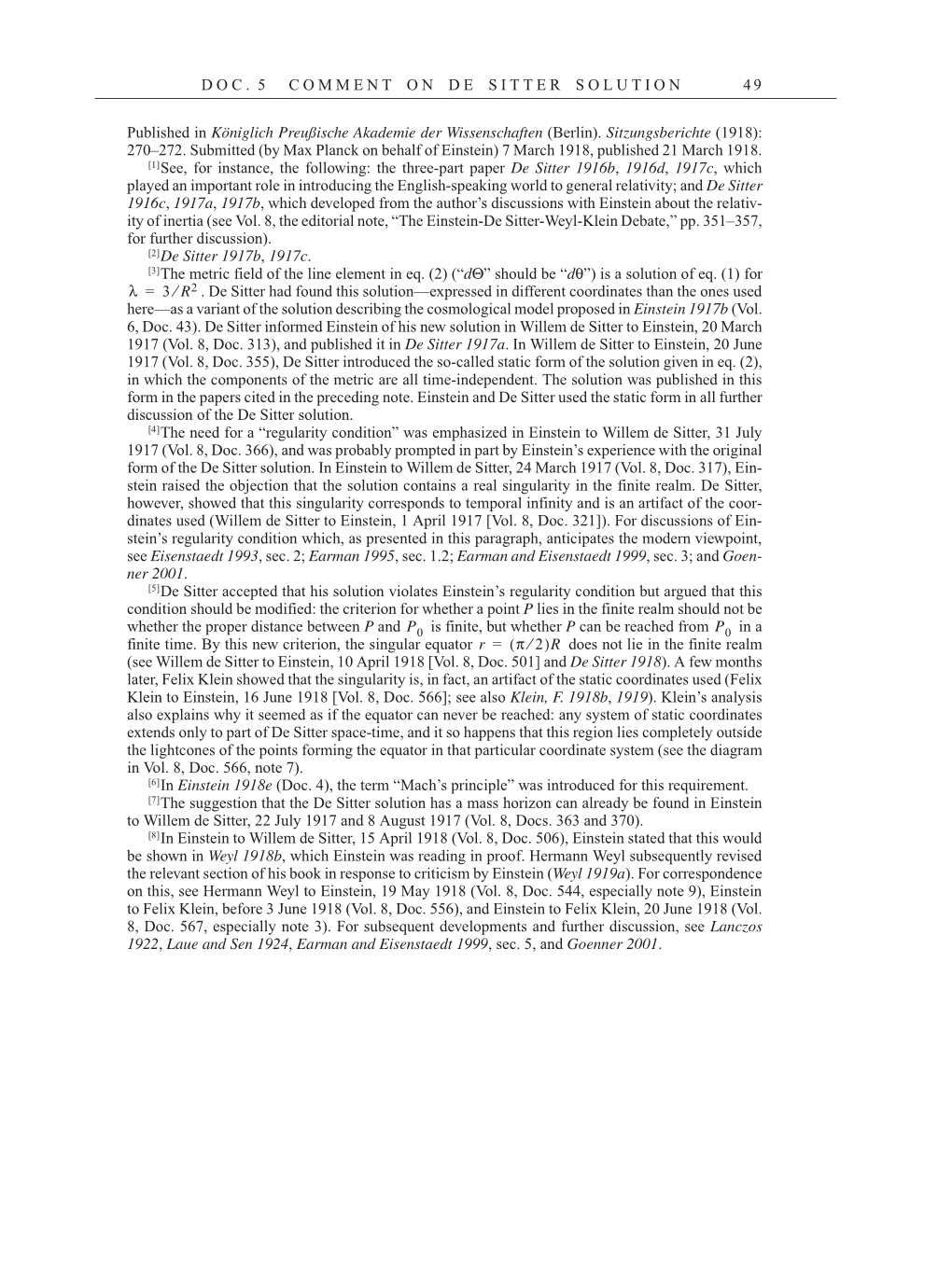D O C . 5 C O M M E N T O N D E S I T T E R S O L U T I O N 4 9
Published in Königlich Preußische Akademie der Wissenschaften (Berlin). Sitzungsberichte (1918):
270–272. Submitted (by Max Planck on behalf of Einstein) 7 March 1918, published 21 March 1918.
[1]See, for instance, the following: the three-part paper De Sitter 1916b, 1916d, 1917c, which
played an important role in introducing the English-speaking world to general relativity; and De Sitter
1916c, 1917a, 1917b, which developed from the author’s discussions with Einstein about the relativ-
ity of inertia (see Vol. 8, the editorial note, “The Einstein-De Sitter-Weyl-Klein Debate,” pp. 351–357,
for further discussion).
[2]De Sitter 1917b, 1917c.
[3]The metric field of the line element in eq. (2) (“dΘ” should be “dθ”) is a solution of eq. (1) for
. De Sitter had found this solution—expressed in different coordinates than the ones used
here—as a variant of the solution describing the cosmological model proposed in Einstein 1917b (Vol.
6, Doc. 43). De Sitter informed Einstein of his new solution in Willem de Sitter to Einstein, 20 March
1917 (Vol. 8, Doc. 313), and published it in De Sitter 1917a. In Willem de Sitter to Einstein, 20 June
1917 (Vol. 8, Doc. 355), De Sitter introduced the so-called static form of the solution given in eq. (2),
in which the components of the metric are all time-independent. The solution was published in this
form in the papers cited in the preceding note. Einstein and De Sitter used the static form in all further
discussion of the De Sitter solution.
[4]The need for a “regularity condition” was emphasized in Einstein to Willem de Sitter, 31 July
1917 (Vol. 8, Doc. 366), and was probably prompted in part by Einstein’s experience with the original
form of the De Sitter solution. In Einstein to Willem de Sitter, 24 March 1917 (Vol. 8, Doc. 317), Ein-
stein raised the objection that the solution contains a real singularity in the finite realm. De Sitter,
however, showed that this singularity corresponds to temporal infinity and is an artifact of the coor-
dinates used (Willem de Sitter to Einstein, 1 April 1917 [Vol. 8, Doc. 321]). For discussions of Ein-
stein’s regularity condition which, as presented in this paragraph, anticipates the modern viewpoint,
see Eisenstaedt 1993, sec. 2; Earman 1995, sec. 1.2; Earman and Eisenstaedt 1999, sec. 3; and Goen-
ner 2001.
[5]De Sitter accepted that his solution violates Einstein’s regularity condition but argued that this
condition should be modified: the criterion for whether a point P lies in the finite realm should not be
whether the proper distance between P and is finite, but whether P can be reached from in a
finite time. By this new criterion, the singular equator does not lie in the finite realm
(see Willem de Sitter to Einstein, 10 April 1918 [Vol. 8, Doc. 501] and De Sitter 1918). A few months
later, Felix Klein showed that the singularity is, in fact, an artifact of the static coordinates used (Felix
Klein to Einstein, 16 June 1918 [Vol. 8, Doc. 566]; see also Klein, F. 1918b, 1919). Klein’s analysis
also explains why it seemed as if the equator can never be reached: any system of static coordinates
extends only to part of De Sitter space-time, and it so happens that this region lies completely outside
the lightcones of the points forming the equator in that particular coordinate system (see the diagram
in Vol. 8, Doc. 566, note 7).
[6]In Einstein 1918e (Doc. 4), the term “Mach’s principle” was introduced for this requirement.
[7]The suggestion that the De Sitter solution has a mass horizon can already be found in Einstein
to Willem de Sitter, 22 July 1917 and 8 August 1917 (Vol. 8, Docs. 363 and 370).
[8]In Einstein to Willem de Sitter, 15 April 1918 (Vol. 8, Doc. 506), Einstein stated that this would
be shown in Weyl 1918b, which Einstein was reading in proof. Hermann Weyl subsequently revised
the relevant section of his book in response to criticism by Einstein (Weyl 1919a). For correspondence
on this, see Hermann Weyl to Einstein, 19 May 1918 (Vol. 8, Doc. 544, especially note 9), Einstein
to Felix Klein, before 3 June 1918 (Vol. 8, Doc. 556), and Einstein to Felix Klein, 20 June 1918 (Vol.
8, Doc. 567, especially note 3). For subsequent developments and further discussion, see Lanczos
1922, Laue and Sen 1924, Earman and Eisenstaedt 1999, sec. 5, and Goenner 2001.
λ 3 R2
⁄ =
P0 P0
r π 2)R ⁄ ( =
